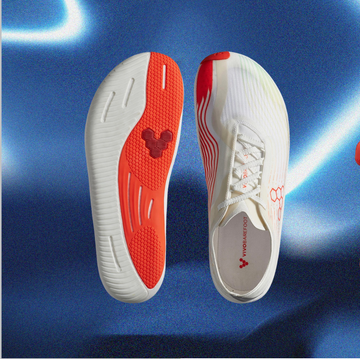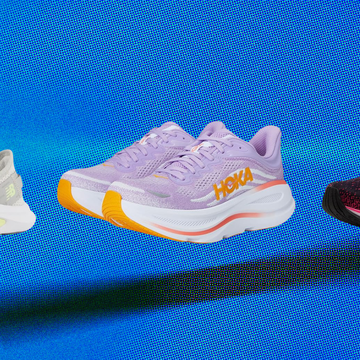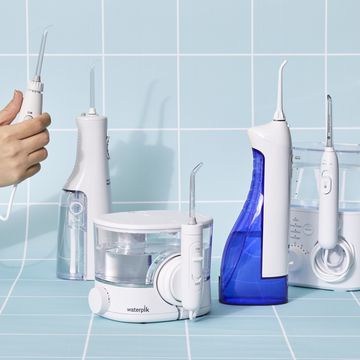Jump to:
- What are carbon plate running shoes?
- Pros and cons of carbon plate running shoes
- Do carbon plate running shoes make you faster?
- Are carbon plate running shoes worth it?
- Our favorite carbon plate running shoes
- How we tested carbon plate running shoes
- What to consider when shopping for carbon plate running shoes
- Why trust Good Housekeeping?
Athletes are often searching for the latest and most innovative clothing and gear that will help them achieve their goals. Carbon plate running shoes are one of the latest breakthroughs in the running shoe category and have become popular among marathoners and those who run long distances. Almost every popular running shoe brand sells a carbon plate option these days and I often spot runners sporting these shoes on race day.
There remains some uncertainty about whether the style can actually make you run faster and many runners are dubious of the high price. I teamed up with experts in the Good Housekeeping Institute Textiles Lab to learn more about this shoe category and interviewed multiple runners on their experiences with carbon plate shoes. We tested two popular styles over multiple weeks and gathered feedback on performance, comfort, design and more.
What are carbon plate running shoes?
"Carbon running shoes feature a carbon fiber plate embedded in the insole to help the wearer run faster," explains Textiles, Paper and Apparel Lab Associate Director Emma Seymour. They have a thick sole often made with PEBA foam which helps give runners a bouncier, springier stride. Carbon plate shoes are designed to be lightweight and usually have a curved sole or rocker style to help propel you forward.
Pros and cons of carbon plate running shoes
Since carbon plate shoes can run a few hundred dollars, it’s important to weigh the advantages and disadvantages of this type of sneaker.
- Pros: Designed to help you run faster, carbon plate shoes may be a worthy splurge for race day, especially if you frequently run longer distances like half marathons, marathons and ultramarathons. They also “help return energy to your foot,” explains Seymour, which will improve your stride. “You just feel lighter and faster," says competitive distance runner Pavel Marossine. Avid racer Rand Miller adds that there is a also "psychological advantage of knowing you’re wearing the best possible equipment for the job."
- Cons: While they are top-of-the-line running shoes, they are undoubtedly expensive. When we recommend pricier shoes, we lean into the versatility that shoes may offer. But carbon plate shoes are really only designed for speed running and won't perform as well at slower speeds or while walking. After finishing a run in my carbon plate shoes, I walked around for about an hour in the shoes to run errands. I found the extra cushioning and curved sole to be uncomfortable to walk in and a bit unstable on less smooth terrain.
Do carbon plate running shoes make you faster?
Most of our runners say yes but with an asterisk. "Carbon plate running shoes are not well suited for beginner or casual runners, so if you’re new to running, they likely won’t make you any faster," says Seymour.
"New runners should focus on their form and running at a conversational pace, rather than attempting to full-out sprint," explains Assistant Commerce Editor Isabella Cavallo. Even after running for one year, you will naturally pick up the pace and be able to run longer distances with proper training. A casual runner may have a strong stride and pace, but not the same goal of getting a lot faster. On the other hand, if you are an elite runner, then carbon plate shoes may help you lower your marathon time by as much as a few minutes.
Marossine finds carbon plate shoes help him run faster and feel better while training. “Compound that with race-day shoe performance and overall they’re a great benefit to my running goals,” he explains. I often run my fastest during a race because competition and adrenaline are pumping through the air, so it makes sense carbon plate shoes may help you cross the finish line at a faster speed. “All of my fastest times since their introduction have been run in carbon plate shoes,” adds Miller.
While it is difficult to know whether the shoe itself makes you run faster or its psychological advantage is mostly at play is difficult to discern. I didn’t notice a major difference in my speed, but that is most likely because I am getting back in condition with a focus on recovery runs at slower paces.
Are carbon plate running shoes worth it?
Both runners and experts agree that it depends. Choosing a running shoe, whether it's made with a carbon plate or not, comes down to personal preference. "Every runner has different needs and preferences," explains Seymour. "If you’re planning on running fast (like a race or a specific, focused workout), carbon-plated shoes are absolutely worth the extra cost," says Miller.
However, the steep price is not worth it for recreational or beginner runners. They are also not a versatile running shoe that you can wear while walking. But if you are consistently running or are often training for an upcoming race, having multiple pairs of running shoes is always a good idea because they degrade with use. So while I may not run a marathon anytime soon, having a carbon plate running shoe in my rotation is helpful for interval speed training, or fartlek runs, while training or on race day.
Our favorite carbon plate running shoes
Weight: 8.1 oz | Drop: 7 mm
The queen bee of cushioned running shoes, HOKA is known for its supportive (although often chunky) running sneakers. It recently released a new version of its carbon plate running shoes, the Cielo X1 2.0, which is 1.2 ounces lighter than the previous version. It features a winged carbon fiber plate and responsive PEBA foam.
I have tried six HOKA shoes so far and noticed the extra cushion most in the Cielo X1 (although I have not yet tested the 2.0 style). It has a forefoot rocker — or a curved sole — that is designed to help propel you forward. Having never worn a rocker-style shoe before, it took three runs for me to feel more comfortable in the shoe — although I still feel a bit unstable when running on cobblestone paths instead of trails or pavement.
I am currently training for a 10k race, but I am not in my best running shape due to aches and pains and the reality of winter weather that so often makes running outside less ideal. That said, I am focusing on slower-paced recovery runs intermixed with fartlek runs. During one speed run, I didn't notice a major difference in my overall pace, although I was able to hit 8 minutes and 30 seconds during one interval. This is typically around my fastest pace on race day, so I am excited to wear the Cielo for my upcoming 10k and continue to conduct long-term testing.
A breathable knit material helped keep my feet cool and the new 2.0 style has stylish cutouts that contribute to the shoe's lightweight design. The original Cielo had a gusseted tongue which made it difficult for the shoelaces to lay flat. I appreciate that the new version lacks this feature and has a cushioned collar for extra ankle comfort. The Cielo is available in gender-neutral sizing and is only available in one color so far, but since it is a new arrival on HOKA's site, more colors may become available down the line.
RELATED: The Best HOKA Shoes
Weight: 5.8 oz | Drop: 8 mm
When Cavallo put on the Nike Vaporfly 3 running shoes, she was blown away by how lightweight they felt on her feet. "These were so light that my mom thought the box was empty and almost threw away the shoes," she said. Cavallo has run in her fair share of running shoes, but nothing compared to how the Vaporfly felt when she took just a few steps in the shoes: "I immediately felt like the outsole was propelling me forward as if I was being led by gravity or the wind."
Marossine finds that the shoe has an "amazing upper with great stability" and considers it a "go-to racing shoe for a 10k through a marathon." In addition to a full-length carbon fiber flyplate, the Vaporfly also features Nike's ZoomX foam from heel to toe to give runners a bouncy feel. The shoes are made from a breathable flyknit material and there is extra cushioning in the heel area as well as a thin rubber outsole that doesn't add too much weight to the shoe.
Miller exclusively runs road mile, 5k and 10k races in the Nike Vaporfly 4, the latest installation in the series that is the lightest running shoe model in Nike's history. "It’s incredibly light and is the most minimalist way to attach a carbon plate to your foot," said Miller. The shoe's energy return and supplemental foot speed were most noticeable as you approach your race pace, reported Miller. With the upcoming release of the Vaporfly 4, there is less inventory in select colors and sizes for the Vaporfly 3. We recommend shopping it now or waiting for the new version to be widely available online.
In addition to performance, the Vaporfly is a stylish sneaker available in eight colors. "Nike frequently releases new color schemes so you can constantly refresh your race-day look," says Miller. Cavallo loved the bright colors and overall appearance of the Vaporfly. She did notice, however, that the insole of one of the shoes slipped out of the sneaker while the other insole was glued tightly on.
RELATED: The Best Nike Shoes for Women
How we tested carbon plate running shoes
Pros in the Good Housekeeping Institute Textiles, Paper and Apparel Lab are constantly evaluating new running shoes both in the Lab and among consumer testers who are paired with a style that fits their preferences. We also team up with medical professionals and running experts to gather further insight into design features.
When testing carbon plate running shoes, we began with extensive research on the category, interviewing our textiles experts as well as runners themselves who wear this style of shoe. After narrowing down two of the most popular running shoe brands that make carbon plate shoes, we tested a style from HOKA and Nike to evaluate fit, comfort, cushioning and, of course, whether the shoes helped us pick up the pace.
What to consider when shopping for carbon plate running shoes
✔️ Comfort: "First and foremost, the shoes should be comfortable to wear," says Seymour. Carbon plate running shoes can take time to get accustomed to, so you want to start off with a comfortable shoe that doesn't pinch your toes or rub against your ankle. We recommend you try on sneakers in a local running store so you can find the right size. If you prefer to shop online, though, check the retailer's return policy to ensure you can order multiple sizes if needed.
✔️ Stability: Marossine says stability is the most important feature he keeps in mind while shopping for a carbon plate running shoe. Shoes that have a smaller stack height (i.e. a shorter amount of distance between your foot and the ground) will provide better stability.
✔️ Weight: As we know from physics, objects that weigh less will accelerate faster. So it only makes sense that shoes meant for speed will feature a lightweight design. Both HOKA and Nike carbon plate shoes have a breathable knit upper that feels lightweight, but the Vaporfly weighs almost half as much as the Cielo. Even so, this HOKA style is still lighter than some of the brand's even chunkier shoes.
✔️ Price: Carbon plate running shoes typically range from around $200 to closer to $300. The HOKA Cielo is the most expensive carbon plate running shoe we have researched so far, while the Nike Vaporfly retails at a slightly lower price and is currently on sale so you can find select colors for under $200.
Why trust Good Housekeeping?
Elizabeth Berry is the updates editor at the Good Housekeeping Institute where she collaborates across Labs to ensure our shopping guides reflect the most recent testing and pricing information. She has researched, tested and written about a variety of sneaker styles from the best HOKA shoes and Brooks shoes to the best running shoes for flat feet. To write this story she interviewed multiple runners and road-tested the HOKA Cielo X1 shoe.
Elizabeth Berry (she/her) is the Updates Editor at the Good Housekeeping Institute where she optimizes lifestyle content across verticals. Prior to this role, she was an Editorial Assistant for Woman’s Day where she covered everything from gift guides to recipes. She also has experience fact checking commerce articles and holds a B.A. in English and Italian Studies from Connecticut College.












